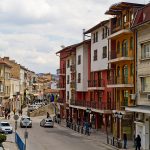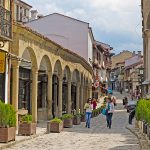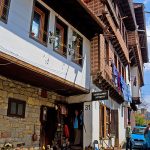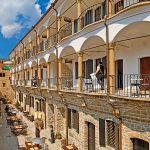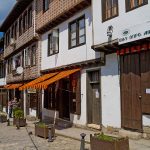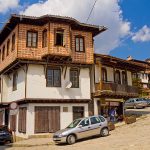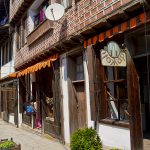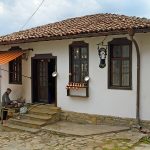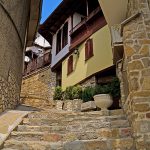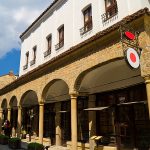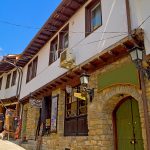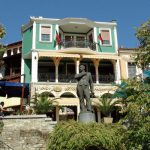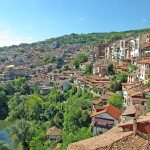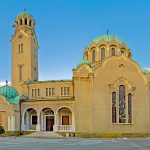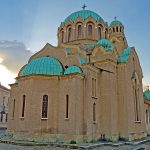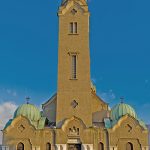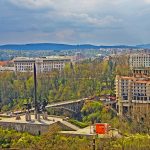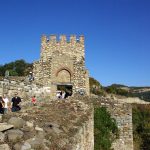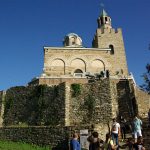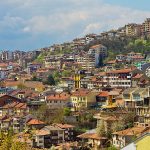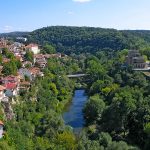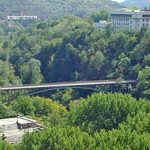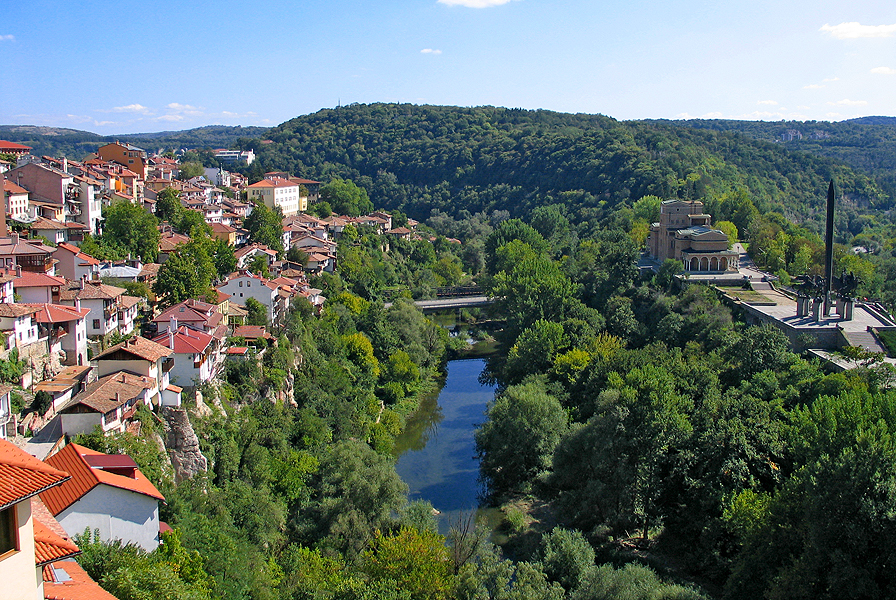
Veliko Tarnovo
Veliko Tarnovo is a town situated in North Bulgaria, an administrative center of the Veliko Tarnovo county.
The town is situated in the valley of the river Yantra, at a distance of 241 km from the capital – Sofia, 228 km from the city of Varna, and 107 km from the town of Ruse.
The Gorna Oryahovitsa airport is situated at a distance of 10 km from Veliko Tarnovo. This is the closest airport to the town. One can also reach Veliko Tarnovo by bus or by train. There is regular transportation from the larger towns and cities.
The town population is approximately 70 000 people, and the area on which it is situated amounts to 30.4 square meters. The location of the town as a crossroad and crossing point of multiple roads and commercial connections and routes had helped for its economical and cultural development from antiquity to the present day.
Veliko Tarnovo is one of the oldest towns in the country, as its history dates back to more than five thousand years ago, which is proven by archaeological excavations.
The upsurge of Veliko Tarnovo is related to the period of the Second Bulgarian Kingdom (1185 – 1393). In 1185 the town was declared a capital of the restored Bulgarian State by the brothers Asen and Petar, who declared the end of the Byzantine dominion, which continued for 167 years.
After its selection to be a capital, the town developed fast, as within the period 12th – 14th century it was the most unconquerable Bulgarian fortress, as well as a cultural and intellectual center of Bulgaria.
The most significant monument of culture in Veliko Tarnovo is the medieval fortress Tsarevets, situated on the homonymous peak, surrounded on three sides by the river Yantra. Excavations show that although Tsarevets is surrounded by a fortified wall, it was not a closed fortress, but a real medieval town, in the center of which the following objects were rising: the palace, the church “St. Petka”, multiple residential and economic buildings, water reservoirs and battle towers.
The Patriarch’s residence was on the highest part of Tsarevets, and the Patriarch’s church “The Ascension of Christ” was also in close proximity.
There is also another historical hill near Tsarevets – Trapezitsa. Its historical richness is great and has not been completely discovered yet. The archaeological excavations on the hill continue and new interesting finds constantly appear on the surface.
Besides its historical hills, Veliko Tarnovo is also famous for its multiple orthodox temples. One of the most emblematic medieval churches is the temple “St. Forty Holy Martyrs”, constructed in honor of the triumph of Tsar Ivan Asen II (1218 – 1241) over the Epir Despot Teodor Komnin (1180 –1273).
The Bulgarian tsars Kaloyan (1168 – 1207), Ivan Asen II were buried here, as well as many other members of the royal families and the Bulgarian aristocracy. The orthodox temple stores some of the most valuable old Bulgarian epigraph monuments – the Omurtag column, the Asen column and the Border column of the Rodosto fortress from the time of Khan Krum (755 –814).
Some of the most popular Bulgarian monasteries – Patriarsheski, Preobrazhenski, Arbanashki, Plakovski, Kapinovski, Kilifarevski, etc., are situated in the vicinity of the town.
During the Age of Revival (18th – 19th century) Veliko Tarnovo was an attractive place for the Bulgarian intellectuals. The town was also a center of the First Revolutionary Region during the April Uprising of 1876 against the Ottoman dominion.
After the Liberation of Bulgaria from Ottoman dominion in 1878 Veliko Tarnovo was the temporary capital of the country. In 1879 the First Constituent Assembly was called, on which the so called Tarnovo Constitution was adopted. Here was the First Grant National Assembly was also established. It elected Prince Alexander I of Batenberg (1857 – 1893) for Bulgarian ruler.
In architectural terms, the appearance of the old part of the town takes the visitors in the past. Walking along Gurko street or Samovodskata Charshia (the crafts streets), the town guests have the possibility to see houses built over 200 years ago, as well as to sense a completely different atmosphere. The market street is a kind of an ethnographic complex with crafts workshops, souvenir shops and galleries.
The larger portion of the local museums, are situated in the old part of the town. Some of the most interesting of them include; the Archaeological Museum, the Museum of Revival and Constituent Assembly, Museum of Contemporary and Most Contemporary History, the Sarafkina House, the Museum House of P. R. Slaveykov, the Stambolov Inn, the Inn of Hadzhi Nikoli, etc.
The archaeological reservation Nikopolis Ad Istrum – a Roman and Early Byzantine town, founded by the emperor Trayan (98 – 117) in 106 AD is situated at a distance of 20 km from Veliko Tarnovo.
The architectural reservation Arbanasi is situated at a distance of only 6 km from Veliko Tarnovo. The ancient village had preserved magnificent architectural monuments of the Age of the Bulgarian Revival, old churches and beautiful yards filled with flowers and greenery.
22 March is the official day of Veliko Tarnovo. This date is related to the historical triumph of Tsar Ivan Asen II over the Teodor Komnin (1230). Traditionally, the evening of the festal day is assigned for a free performance on the Tsarevets hill.
The audio-visual performance “Sound and Light” speaks of the glorious and tragic history of Bulgaria via music, lights, lasers and church bells, which makes it a unique attraction for the country. Performances are also organized during the rest of the year upon a preliminary request in exchange for payment.
It is not accidental that Veliko Tarnovo was declared a Balkan capital of cultural tourism, and a few times it was awarded the prize The Most Beautiful Town in Bulgaria, as a result of annual research conducted by the media. The town really is magnificent with its beautiful houses, perching amphitheatrically along the river banks; it has a rich history of landmarks that are attractive for the guests.
The options for accommodation in the town are exceptionally diverse – private accommodation, hostels, guest houses and hotels up to 4 stars. The town offers rich possibilities for entertainment and night life – discotheques, bars, restaurants, etc.
The main street of the town offers a large variety of shops, hotels, entertainment and catering establishments. The restaurants in the town are famous for their delicious cuisine. Here you can taste popular Bulgarian dishes and ones that are typical for the region.
There are multiple eco paths for the fans of active relaxation – the Negovanska path (in the village of Emen), Preobrazhenska path, Arbanashka path, etc. The eco paths are marked walking routes in the nature, by means of which the tourists get access to beautiful local and natural landmarks.
The region offers options for rock climbing, mountain cycling, horse back riding, and the multiple rivers and dams provide options for fishing and swimming.
You can receive more information about hotels, restaurants, landmarks, transportation, various attractions and current events, cars for rent, and the current state of the eco paths in the tourist information center in the town, which is situated in the central part of the town.
There you can purchase information materials for the sites in Tarnovo, as well as make a request for the Sound and Light performance.
Veliko Tarnovo, Veliko Tarnovo Province, Bulgaria.

